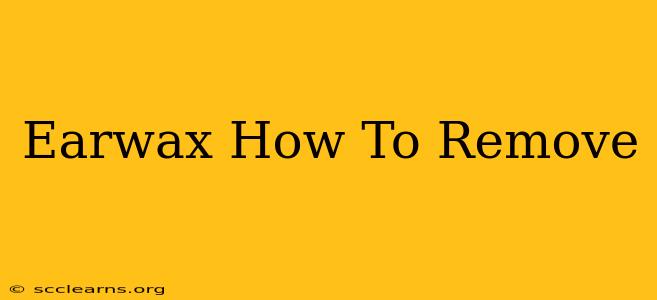Earwax, or cerumen, is a naturally occurring substance produced by glands in your ear canal. It plays a vital role in protecting your ears from infection, dust, and debris. While usually self-cleaning, sometimes earwax buildup can occur, leading to discomfort, hearing impairment, or even infection. This guide will walk you through safe and effective methods for earwax removal, emphasizing when professional help is necessary.
Understanding Earwax Buildup
Before attempting any earwax removal, it's crucial to understand why you might have a buildup. Several factors contribute to excessive earwax:
- Narrow ear canals: Individuals with naturally narrow ear canals are more prone to blockages.
- Hairy ear canals: Hair can trap wax, hindering its natural expulsion.
- Cotton swabs: Ironically, using cotton swabs to clean your ears often pushes wax deeper, leading to impaction.
- Hearing aids: These devices can sometimes interfere with the natural movement of earwax.
- Certain medications: Some medications can affect cerumen production.
Identifying symptoms of excessive earwax:
- Feeling of fullness or pressure in the ear
- Muffled hearing
- Earache
- Itching
- Discharge (may indicate infection)
Safe Methods for Earwax Removal at Home
Never insert anything small and sharp into your ear canal. This could cause serious damage to your eardrum. Here are some safe at-home options:
1. Softening the Earwax
The first step is often softening the wax to make it easier to remove. You can do this by:
- Using ear drops: Over-the-counter ear drops designed to soften earwax are readily available at pharmacies. Always follow the instructions carefully.
- Warm water irrigation: Carefully using a bulb syringe filled with warm water can help dislodge softened earwax. This should only be done if you're comfortable and have some experience. Improper technique can damage the eardrum.
2. Gentle Irrigation (with caution)
If you choose to irrigate, use lukewarm water and a bulb syringe. Tilt your head to the side, aiming the stream at the top of the ear canal to flush out the wax. Do not use forceful pressure. If you experience any discomfort or dizziness, stop immediately.
3. Hydrogen Peroxide (use cautiously)
Some people use a diluted solution of hydrogen peroxide, but it's essential to use it sparingly and with caution. Dilute a small amount of 3% hydrogen peroxide with an equal part of water, then apply a few drops. It may cause some slight fizzing, which helps loosen the wax. Do not use this method frequently.
When to See a Doctor
While home remedies can be effective for mild earwax buildup, it's crucial to seek professional medical help if:
- You experience severe pain or dizziness.
- Your hearing loss is significant or sudden.
- You have signs of infection (pus, fever, severe pain).
- Home remedies are ineffective.
- You have a perforated eardrum (a hole in the eardrum).
A doctor or audiologist can safely and effectively remove impacted earwax using techniques such as suction or micro-irrigation. They can also rule out any underlying medical conditions.
Preventing Future Buildup
The best approach is prevention! Here's how to minimize future earwax problems:
- Avoid using cotton swabs: This is the most crucial step.
- Keep your ears dry: Use earplugs when swimming.
- Consult your doctor or audiologist about appropriate ear cleaning methods.
Remember, earwax is a natural and important part of your ear's defense mechanism. Managing it correctly can ensure healthy ears and optimal hearing. Prioritize safety, and don't hesitate to seek professional help when needed.

